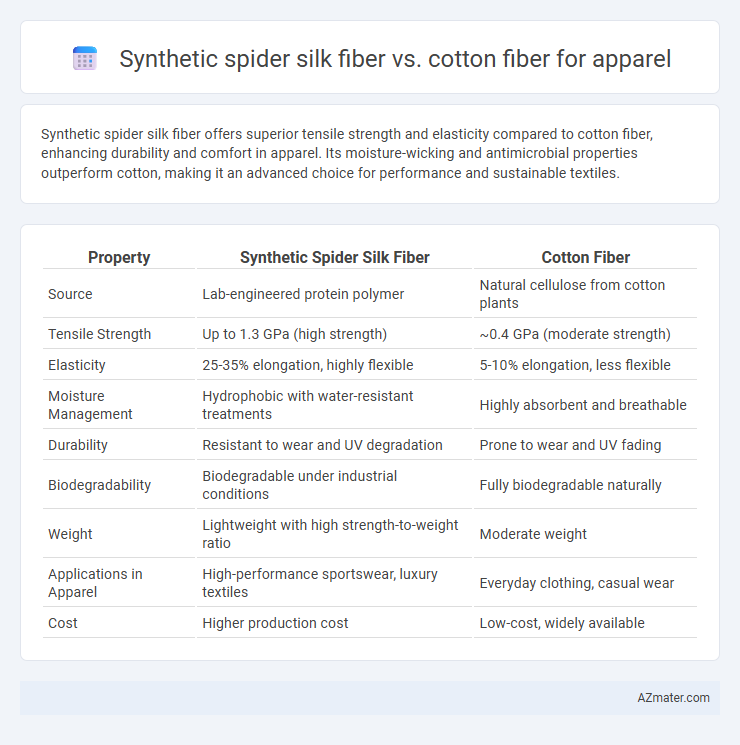Synthetic spider silk fiber offers superior tensile strength and elasticity compared to cotton fiber, enhancing durability and comfort in apparel. Its moisture-wicking and antimicrobial properties outperform cotton, making it an advanced choice for performance and sustainable textiles.
Table of Comparison
| Property | Synthetic Spider Silk Fiber | Cotton Fiber |
|---|---|---|
| Source | Lab-engineered protein polymer | Natural cellulose from cotton plants |
| Tensile Strength | Up to 1.3 GPa (high strength) | ~0.4 GPa (moderate strength) |
| Elasticity | 25-35% elongation, highly flexible | 5-10% elongation, less flexible |
| Moisture Management | Hydrophobic with water-resistant treatments | Highly absorbent and breathable |
| Durability | Resistant to wear and UV degradation | Prone to wear and UV fading |
| Biodegradability | Biodegradable under industrial conditions | Fully biodegradable naturally |
| Weight | Lightweight with high strength-to-weight ratio | Moderate weight |
| Applications in Apparel | High-performance sportswear, luxury textiles | Everyday clothing, casual wear |
| Cost | Higher production cost | Low-cost, widely available |
Introduction to Synthetic Spider Silk and Cotton Fibers
Synthetic spider silk fiber mimics the natural protein structure of spider dragline silk, offering exceptional strength and elasticity, making it highly suitable for advanced apparel applications requiring durability and comfort. Cotton fiber, derived from the cellulose of cotton plants, is widely valued for its softness, breathability, and moisture absorption, making it a staple in everyday clothing. The comparison highlights synthetic spider silk's superior tensile strength and biodegradability against cotton's natural, renewable source and widespread availability.
Fiber Structure and Composition
Synthetic spider silk fiber exhibits a unique protein-based structure composed primarily of spidroin molecules arranged in highly organized beta-sheet crystals, providing exceptional tensile strength and elasticity. In contrast, cotton fiber is a natural cellulose-based polymer with a primarily amorphous structure interspersed with crystalline regions, resulting in softness and breathability but lower mechanical strength. The molecular design of synthetic spider silk allows for enhanced durability and moisture management in apparel compared to the hydrophilic and less resilient nature of cotton fibers.
Mechanical Properties: Strength and Flexibility
Synthetic spider silk fiber exhibits superior tensile strength and elasticity compared to cotton fiber, making it highly durable and resistant to wear in apparel applications. Its high tensile strength, often surpassing steel on a weight-to-strength ratio, allows garments to withstand significant stress without tearing. The exceptional flexibility of synthetic spider silk enhances comfort and fit by allowing greater movement and recovery, outperforming cotton's relatively lower stretchability and mechanical resilience.
Moisture Management and Breathability
Synthetic spider silk fiber exhibits superior moisture management compared to cotton fiber due to its hydrophobic properties combined with excellent wicking capabilities, enabling faster evaporation of sweat and enhanced skin dryness. Breathability is enhanced in synthetic spider silk fiber through its micro-porous structure, which facilitates better air circulation and temperature regulation than the denser, less permeable cotton fiber. These characteristics make synthetic spider silk fiber an advanced material for activewear and high-performance apparel, offering improved comfort and thermal regulation under various conditions.
Comfort and Softness in Apparel
Synthetic spider silk fiber offers superior comfort and softness compared to traditional cotton fiber due to its exceptional elasticity and lightweight structure, which conform closely to the skin while maintaining breathability. Unlike cotton, which can retain moisture and feel heavier when damp, synthetic spider silk exhibits moisture-wicking properties that enhance wearability in various climates. The fine, smooth texture of synthetic spider silk reduces irritation and friction, making it an ideal choice for high-performance and luxury apparel.
Environmental Impact and Sustainability
Synthetic spider silk fiber offers superior environmental benefits compared to conventional cotton fiber, as it requires significantly less water and land resources during production. Unlike cotton farming, which often relies on intensive pesticides and fertilizers, synthetic spider silk is produced through bioengineered processes that minimize chemical use and greenhouse gas emissions. Its biodegradability and high strength-to-weight ratio contribute to a more sustainable apparel industry by reducing waste and extending garment durability.
Durability and Longevity in Garments
Synthetic spider silk fiber exhibits superior durability compared to cotton fiber due to its exceptional tensile strength and resistance to wear and tear, making it ideal for long-lasting garments. Unlike cotton, which degrades faster under repeated washing and exposure to sunlight, synthetic spider silk maintains its structural integrity and vibrant appearance over time. These qualities result in apparel that retains shape, strength, and softness far beyond the typical lifespan of conventional cotton clothing.
Dyeability and Aesthetic Appeal
Synthetic spider silk fiber demonstrates superior dyeability compared to cotton fiber due to its protein-based structure, enabling vibrant and long-lasting color retention. Unlike cotton, synthetic spider silk offers enhanced aesthetic appeal with a natural sheen and smooth texture that mimics traditional silk, providing a luxurious finish to apparel. Its engineered consistency allows for uniform dye absorption, resulting in more vivid and customizable textile designs.
Cost and Scalability of Production
Synthetic spider silk fiber offers higher tensile strength and durability compared to traditional cotton fiber, but its production cost remains significantly higher due to complex biotechnological processes. Cotton fiber benefits from well-established scalable agricultural systems, resulting in lower costs and large-scale availability worldwide. As synthetic spider silk manufacturing technologies advance and scale up, cost reductions are anticipated, potentially positioning it as a competitive alternative in high-performance apparel markets.
Future Prospects in Apparel Innovation
Synthetic spider silk fiber offers superior strength, elasticity, and biodegradability compared to traditional cotton fiber, making it a promising material for next-generation apparel innovation. Advances in biotechnology and scalable production methods are accelerating the integration of synthetic spider silk into sustainable fashion, enhancing performance and comfort while reducing environmental impact. Future apparel designs will likely leverage synthetic spider silk's unique properties to create durable, lightweight, and eco-friendly clothing options that meet growing consumer demand for sustainable textiles.

Infographic: Synthetic spider silk fiber vs Cotton fiber for Apparel
 azmater.com
azmater.com